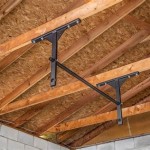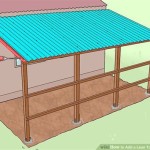How To Hang Bikes In Garage From Ceiling
Maximizing garage space is a common concern for homeowners. Bicycles, while providing a healthy mode of transportation and recreation, can often contribute to garage clutter. Hanging bicycles from the ceiling is an effective solution for freeing up floor space and keeping bikes organized. This article details the process of safely and effectively hanging bikes in a garage from the ceiling, covering essential considerations, material selection, installation steps, and safety precautions.
Assessing Your Garage and Bike
Before initiating the process of hanging bikes from the ceiling, a thorough assessment of the garage structure and the bicycles themselves is crucial. This preliminary step ensures compatibility and safety.
Firstly, the ceiling structure must be evaluated. Identify the ceiling joists or rafters. These are typically spaced 16 to 24 inches apart on center. Using a stud finder can accurately locate these structural members. Avoid attaching bike hanging systems directly to drywall or ceiling panels, as these materials lack the necessary strength to support the weight of a bicycle. The joists or rafters should be made of solid wood and free from rot or damage. If the joists are engineered wood products, consult the manufacturer’s specifications to ensure their load-bearing capacity is sufficient for the weight of the bikes being stored.
Secondly, assess the height of the garage ceiling. Measure the distance from the floor to the ceiling joists. This measurement is critical in determining the length of the hanging mechanism. It is essential to ensure that the bikes, when suspended, will not obstruct movement within the garage or pose a hazard to vehicles. Aim for a clearance of at least 6 to 12 inches between the lowest point of the hanging bicycle and the head height of the tallest members of the household or any equipment stored below.
Thirdly, consider the weight and type of bicycles to be stored. Different bicycles have varying weights and frame geometries. Mountain bikes and e-bikes are significantly heavier than road bikes or children’s bikes. The chosen hanging system must be rated to support the combined weight of the bicycles being stored, with a safety margin to account for dynamic loading and potential variations in weight distribution. Also, the frame geometry of the bicycle will influence the choice of hanging mechanism. Some systems are better suited for certain frame types than others.
Finally, determine the available space for maneuvering the bicycles during the hanging and retrieval process. Ensure there is sufficient clearance to lift the bike and position it onto the hanging mechanism without damaging the bike, the garage walls, or other stored items.
Selecting the Appropriate Hanging System
Several different types of bike hanging systems are available, each with its own advantages and disadvantages. Selecting the right system depends on factors such as budget, ceiling height, bicycle weight, and personal preference.
Hook Systems: These are among the simplest and most affordable options. Hook systems typically consist of two hooks that are screwed directly into the ceiling joists. The user lifts the bike and hangs it by the front and rear wheel rims. While relatively easy to install, hook systems require a significant amount of lifting strength to raise the bike to the ceiling. They may also cause some wear and tear on the tire rims over time. Hooks should be coated with rubber or plastic to prevent damage to the rims.
Pulley Systems: Pulley systems utilize a series of ropes and pulleys to lift the bike to the ceiling with minimal effort. These systems are ideal for heavier bikes or individuals with limited lifting strength. The user attaches the bike to the system via hooks or straps, and then pulls on a rope to raise the bike. A locking mechanism secures the bike in the raised position. Pulley systems tend to be more expensive than hook systems but offer greater ease of use and safety.
Rack Systems: Rack systems involve a more elaborate setup, often consisting of a track mounted to the ceiling and adjustable arms or brackets that hold the bikes. These systems can be more expensive and complex to install, but they offer greater flexibility in terms of bike positioning and storage density. They are also suitable for storing multiple bikes in a compact space. Some rack systems allow for horizontal storage along the ceiling, maximizing vertical space.
Electric Lift Systems: For the ultimate in convenience, electric lift systems are available. These systems use an electric motor to raise and lower the bike with the push of a button. While the most expensive option, electric lift systems are ideal for individuals with mobility limitations or for storing very heavy bikes. Installation requires electrical wiring and may necessitate professional assistance.
When selecting a hanging system, carefully review the product specifications, including the weight capacity, material construction, and included hardware. Choose a system from a reputable manufacturer and ensure it meets applicable safety standards. Read customer reviews to gain insights into the system's performance and reliability.
Installation Procedure
The installation process will vary depending on the type of hanging system chosen. However, general steps must be followed to ensure a safe and secure installation.
Safety First: Before commencing any work, prioritize safety. Wear safety glasses to protect the eyes from debris. If using power tools, wear hearing protection. Disconnect power to any electrical circuits in the work area to prevent electrical shock. Ensure the work area is well-lit and free from obstructions.
Locate and Mark Joists: Using a stud finder, accurately locate the ceiling joists or rafters. Mark the center of the joists where the hanging system will be attached. Use a pencil or marker to clearly indicate the attachment points. Double-check the measurements to ensure accuracy.
Pilot Holes: Drill pilot holes into the joists at the marked locations. The pilot holes should be slightly smaller than the diameter of the screws or bolts used to secure the hanging system. Pilot holes prevent splitting the wood and ensure a secure connection.
Attach the Hanging System: Following the manufacturer’s instructions, attach the hanging system to the ceiling joists. Use appropriate screws or bolts that are designed for wood attachment and are long enough to penetrate deep into the joists. Ensure the fasteners are tightened securely, but avoid over-tightening, which could strip the threads or damage the wood.
Test the System: Before hanging the bike, test the installed system by applying a simulated load. Gently pull down on the hanging mechanism to ensure it is securely attached and can support the weight. If using a pulley system, test the locking mechanism to ensure it functions properly.
Hang the Bike: Carefully lift the bike and position it onto the hanging mechanism. Ensure the bike is properly balanced and securely supported. If using a hook system, ensure the hooks are fully engaged with the tire rims. If using a pulley system, slowly raise the bike to the desired height and engage the locking mechanism. If using a rack system, adjust the arms or brackets to securely hold the bike.
Final Inspection: After hanging the bike, conduct a final inspection to ensure everything is properly installed and functioning correctly. Check that the bike is stable and secure, and that it does not pose a hazard to anyone using the garage. Make any necessary adjustments to ensure the system is safe and reliable.
Maintenance Periodically inspect the hanging system for signs of wear and tear. Check the ropes, cables, and hardware for damage. Tighten any loose fasteners. Lubricate moving parts as needed. Replace any worn or damaged components promptly.
Safety Considerations
Safety is paramount when hanging bikes from the ceiling. Following established safety guidelines will help prevent accidents and injuries.
Weight Capacity: Never exceed the weight capacity of the hanging system. Overloading the system can lead to failure and potentially cause serious injury. If you are unsure of the weight of your bike, weigh it using a bathroom scale. Choose a hanging system with a weight capacity that exceeds the weight of your bike by a significant margin.
Secure Attachment: Ensure the hanging system is securely attached to the ceiling joists or rafters. Use appropriate fasteners and follow the manufacturer’s instructions carefully. Regularly inspect the attachment points for signs of loosening or damage. Replace any damaged fasteners immediately.
Proper Lifting Technique: Use proper lifting techniques when raising and lowering the bike. Bend your knees and keep your back straight. Avoid twisting or straining your back. If the bike is too heavy to lift comfortably, consider using a pulley system or enlisting assistance from another person.
Clearance: Ensure there is sufficient clearance around the hanging bike. Avoid placing the bike in areas where it could obstruct movement or pose a hazard to vehicles or pedestrians. Be mindful of head height and ensure the bike is hung high enough to prevent accidental contact.
Children and Pets: Keep children and pets away from the hanging bike. The bike could fall and cause injury. Store the bike in a secure location that is inaccessible to children and pets.
Regular Inspection: Periodically inspect the hanging system and the bike for signs of wear and tear. Check the ropes, cables, hooks, and fasteners for damage. Replace any worn or damaged components immediately. Regular maintenance will help ensure the system remains safe and reliable.

Hanging Bike Garage Organization The Sunny Side Up Blog

Hanging Bike Garage Organization The Sunny Side Up Blog

Hanging Bike Garage Organization The Sunny Side Up Blog

15 Practical Bike Storage Ideas Garage And Indoors Demo

Hanging Bike Garage Organization The Sunny Side Up Blog

How To Hang A Bike From The Ceiling C R F T

Wall Ceiling Bike Rack Under 50

Hang Your Bike From Garage Joists Enjoy The House

Simple Ways To Hang Bikes From The Ceiling With Pictures

Hang Bikes In The Garage Check
Related Posts








